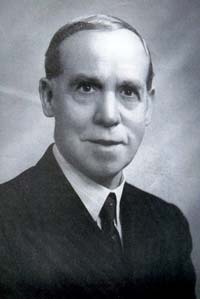THEY LIVED IN LEEDS
Snowden Schofield (1870-1949)
Founder of an iconic Leeds business
 Leeds has just celebrated the opening of the ambitious, multi-million new Trinity Centre, designed to draw customers from afar to this shoppers’ paradise. Fifty years ago, in 1962, another landmark shopping enterprise was celebrated in Leeds: the completion of the streamlined new building of Schofield’s Department Store in the Headrow (where ‘The Core’ is now). Schofield’s, still fondly remembered, was a family enterprise, founded in 1901 by a young Bradford man, Snowden Schofield, in a modest shop nearby. Schofield’s was to become a household name in Leeds, its expansion mirroring the growth and prosperity of the city.
Leeds has just celebrated the opening of the ambitious, multi-million new Trinity Centre, designed to draw customers from afar to this shoppers’ paradise. Fifty years ago, in 1962, another landmark shopping enterprise was celebrated in Leeds: the completion of the streamlined new building of Schofield’s Department Store in the Headrow (where ‘The Core’ is now). Schofield’s, still fondly remembered, was a family enterprise, founded in 1901 by a young Bradford man, Snowden Schofield, in a modest shop nearby. Schofield’s was to become a household name in Leeds, its expansion mirroring the growth and prosperity of the city.
Snowden Schofield was born in Bradford in 1870, the son of a joiner. After his first job in a draper’s, he moved to London as sales assistant in one of the prestigious, elegant Knightsbridge stores: high class experience. Ambitious and energetic, he moved on to a position with Owen Owen in Liverpool, and there in 1901 he married and started thinking about launching his own business. He visited a friend in Leeds with a shop in the newly-opened Victoria Arcade, built to mark Queen Victoria’s diamond jubilee, fronting what was then the narrow Upperhead Row. Although not the best part of town, he was told it was a good pitch, and he took the plunge, renting the opposite corner shop, No.1, at £50 a year.
He set up as a ‘fancy draper’, specialising in fashionable trimmings, lace and ribbons, gloves, hosiery and hats. On the first day the shop was packed and he took over £62 – success! Full of bright new ideas, he began to advertise on the front page of local newspapers (‘a dainty cream silk blouse with lace and all-round frills, only 4s 11½d’), and offered a postal service. Quality and good value were his watchwords. Before long he took over more shops in the Arcade, increased his clothing range, and looked for new opportunities nearby.
Outside the elegant Arcade, narrow cobbled lanes linked crowded courtyards and old buildings, including two long-established theatres, the Hippodrome and the Theatre Royal. Close by stood the historic mansion ‘Red Hall’, built in 1628, where King Charles I had been held captive in 1647 on his way to the executioner’s block in London. The handsome panelled room he had occupied was known as the King’s Chamber (and King Charles Street still exists). In 1912 Snowden Schofield bought Red Hall and incorporated the ancient building into his store. The King’s Chamber was restored as the Tudor Café, where shoppers could be refreshed to the genteel accompaniment of a quintet of lady musicians – they could choose a toasted crumpet for 2d or steak and chips for 1s 4d. Shopping at Schofields was an experience to be enjoyed and savoured.
His path was not always smooth. In 1909, after only eight years together, his wife Mabel died, leaving him with a young family, but his wife’s sisters rallied round to help and he was able to focus on his growing business. The First World War intervened, but by the 1920s he was ready to extend again, acquiring further buildings along the narrow main road, now scheduled to be rebuilt as the handsome new Headrow. In the 30s he acquired the Hippodrome when it closed, and later the ‘Cock and Bottle’ inn which had stood in his way. He began to envisage creating a new, modern store from this patchwork of property, to meet every need – from furs to furniture, from silks to saucepans. But again war intervened and his plans had to be shelved. Development began again post-war, when he bought the Victoria Arcade, home of his first shop, and linked it to the other buildings.
But in March 1949 he died, aged 79 – more than a thousand people followed his funeral. His two sons took over the business and the plans for redevelopment. In the late 1950s, after acquiring the Theatre Royal, a staged programme of demolition, clearance and construction was implemented. The historic quarter of Red Hall, the theatres, the Arcade all vanished, and by 1962 the six-storey flagship Schofields building was completed. For the next twenty years it was Leeds’ premier department store, still remembered today for its friendly atmosphere, its quality service, its three restaurants, its Food Hall to rival Harrods (where smoked salmon trimmings were given away at day’s end), its uniformed lift attendants, the magic of the flying cash tubes, which Snowden Schofield had been the first to introduce to Leeds in 1906. Until Peter Schofield’s retirement and its sale in 1984 it remained a family firm, valued by its loyal customers and staff. Snowden Schofield would have been proud of that.
Eveleigh Bradford
July 2013
See also Eve's talk on the watercolour and history of Red Hall